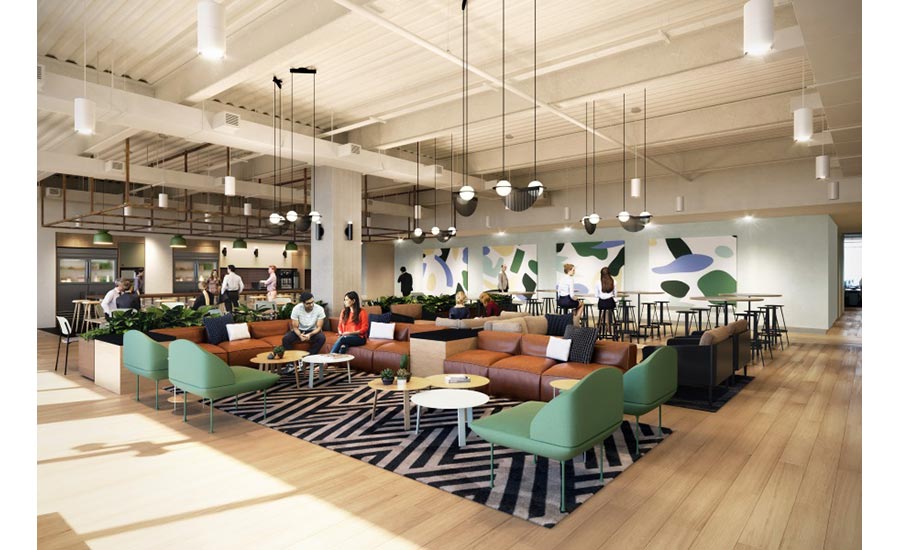Nic Rader says his job is one of the most exciting jobs at WeWork, a company that provides shared workspaces for startups, freelancers, small businesses, and large enterprises. As head of design for Powered by We—a business model that includes custom design, portfolio analysis, and office-management services—he describes his role as the emcee of “a startup within a startup within a startup.”
Rebranded as The We Company and reportedly valued at $47 billion, WeWork is edging into the commercial real–estate market and other businesses. According to an internal annual report, the company is now the largest private occupier of space in London, Washington DC, and Manhattan.
So now, rather than paying for space inside a WeWork-leased property, companies such as Sprint and UBS are using Powered by We for their own properties’ redesign and operation. This represents a large potential market: WeWork’s bank of 2,000 enterprise-level clients (companies with more than 1,000 employees) represent workers from 30 percent of Fortune 500 companies.
Figuring out how to offer space as a service is the crux of Rader’s job. He leads a team of engineers, architects, workplace strategists, BIM specialists, and graphic designers who use work-habit data and insights to create efficient, community-oriented workspaces. The data and insight are gathered from interviews, surveys, and WeWork’s member app. These spaces, Rader says, help companies streamline their real-estate concerns and accelerate growth.
Will WeWork become the Amazon of office space? Here, Rader shares his thoughts on the creative side of a program bent on recasting architecture from a set of designs to a scalable, data-driven service.
You spent 10 years as an architect and project director at architecture and design firm Snøhetta. How do you apply your training and experience at WeWork?
At Snøhetta, we did everything from a kitchen and courtyard renovation at the iconic Napa Valley restaurant The French Laundry to the Golden State Warriors arena—aka Chase Center [in San Francisco]—to a master plan for a proposed Obama presidential center in Honolulu. Those experiences helped me hone the architecture training I got in college, which is essentially complex problem solving.
You have to look at a problem from different angles and bring people in who are experts in things you are not. At WeWork, some projects are custom builds, but not every project is different every time. We’re trying to build a platform around a product we can scale and build. That brings with it really gnarly problems, which require outside experts and benefit from an architect’s problem-solving skill set.
Powered by We has been described as “office space as a service.” What does that entail?
In essence, we take our understanding of workplace experiences from WeWork spaces and tailor that to the culture, brand, and work style of clients. It’s not just design and build. It’s community management, software integration, real-estate analysis, everything. What we’ve been able to do is unlock the value proposition for enterprise clients. They know our service can increase employee retention, recruitment, efficiency, and competitiveness—and the statistics bear this out.
For WeWork’s renovation of UBS’s Lincoln Harbor campus in New Jersey, what did the office space look like before, and what was the end result?
It’s not so much about how the space looked before our team came in, but more about how the space functioned for UBS at the time. It was important for our designers, architects, and workplace strategists to work closely with UBS to analyze its needs and develop a design strategy to support its goals while meeting its budget and schedule. First, we conducted research that included keeping a record of how the space was being used. That meant working in the space ourselves and interviewing UBS employees to understand what worked well and to identify a few main needs.
How did this preliminary work inform your design thinking?
Based on our research, we developed a strategy that responded to the desire for flexibility and collaboration. This meant providing multi-functional spaces with flexible furnishings that activate the entire floor throughout the day. “Lunch and learns” can be held in the lounge next to the cafeteria, the auditorium can open for receptions, and meeting rooms can divide and expand. New amenities, such as a coffee and juice bar, make the space interactive; and informal breakout spaces are integrated with common spaces to encourage interaction. Finally, we wanted the space to offer a variety of meeting areas, from single-person phone booths to a 500-seat auditorium.
How does the design process typically start?
Every Powered by We client goes through a process of discovery. On the technical side, we laser-scan every single space to get a highly defined point cloud, which we translate into conditions and models using Autodesk Revit and in-house products. This is true BIM, not just traditional documentation in a new platform. It includes all embedded data about the space and its physical products: specifications, cost, logistics, turnaround time, delivery, and collision and detection models. We’re not just pumping out sheet sets. We’re moving quickly to actual scheduling and logistics to advance construction delivery above and beyond intentions and aspirations.
What about the human side? Is there a personalized aspect to the designs?
The first thing that gives our spaces a human quality is, quite simply, humans. Locations can have community managers who get to know every person by name. They ask about peoples’ concerns and what their days are like. They support them in their work. These days the market is competitive in terms of talent, and the benefits of having community managers are more than standard facility managers could offer. They curate the experience; they provide lectures and luncheons, food and wine tastings. They help create connections, and this has a significant benefit in helping companies win the talent war.
Should WeWork’s enterprise design services give architects reason to worry?
I think architects, as people, have nothing to worry about. Given the skill set we have around coordination and the understanding of how to engage experts to solve complex problems, we’re in the unique position to be successful and, actually, lead industry-wide change. That said, if I were a traditional architecture firm, I would be scared. Some firms can be resistant to change, and, as a result, there is a significant reduction in the value in those types of companies and organizations. Those are the people who should worry about this.
This article originally appeared on Autodesk’s Redshift, a publication dedicated to inspiring designers, engineers, builders, and makers.




